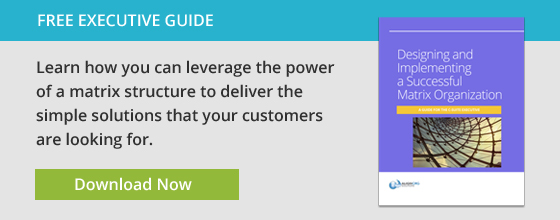So, you’ve determined that a matrix organization aligns with and will drive your strategic objectives. Now what? How do you design the best matrix organization for you?
Setting up a matrix may seem simple—determine where the solid and dotted reporting lines go and send out an email. If our recent executive guide on Designing and Implementing a Successful Matrix Organization hasn’t made the case, let’s be explicit here—designing an effective matrix structure is not a simple task. If you haven’t already engaged a change partner, now is a good time (for more information on how to select a good change partner, click here). To do it right, there are some tried and true steps that will help you architect a matrix for your unique organization situation.
Step 1: Define Organization Capabilities and Strategy
Before any attempt to implement a matrix structure, senior leaders need to align around a distinctive strategy for their business and the unique organization capabilities required. This strategic positioning conversation requires making trade-offs and articulating how the organization will win in the marketplace. As executives reach an aligned view on how the organization will win, how customer needs will be met, and what organization capabilities are needed to deliver distinctive value, decisions can be made about whether a matrix is the right design to facilitate strategic success.
As part of this discussion, executives should consider the following:
- The clear benefits of the matrix for the company strategy and what value they hope to deliver.
- The challenges/trade-offs of a matrix structure and how to mitigate them.
- How the matrix structure will deliver the desired value to the market (keep in mind that structure alone won’t deliver strategy).
- Who are the right, next-level down leadership team(s) who will be instrumental in implementing the matrix design across business units, regions, or functions.
Step 2: Design Supporting Processes, Decision Rights, and Structure
We use the metaphor of a Rubik’s Cube to think about the multiple aspects of an organization that must be aligned to make the organization work optimally. Just like solving the Rubik’s Cube puzzle, where all sides must be aligned, an organization must make sure all aspects of the organization from work, to structure, to metrics, to people, to rewards, and culture are lined up. You don’t get credit for solving the Rubik’s Cube if only the green side is in place—you must solve for all six sides of the cube. Similarly, you must solve for all aspects of a matrix organization design to get the most out of it.
In this phase of design, the senior leadership team begins to answer how the organization will work going forward and what mechanisms will keep the matrix running smoothly. In a newly formed matrix, one of the biggest issues is determining decision rights not only for those who have the final say, but also how others in the matrix weigh in and contribute to the decision-making process. You will need to define what is expected of both leaders and employees in terms of performance, coordination, and behaviors. You will also have to establish processes and expectations for resolving conflicts.
As the matrix introduces intersecting processes and a new web of interconnections among leaders and employees, executives and their change partners need to keep several questions in mind that will help them develop a successful matrix:
- How will the organization set priorities, allocate resources, and realize intended marketplace differentiation through the structure?
- Who gets credit for good performance and who takes responsibility for a critical mistake (e.g., sales, marketing, etc.)?
- How are costs shared and allocated among the different functional groups (charge-backs or some other method)?
- How will employees juggle their shared and dedicated capabilities? Which ones take precedence at any given time?
At this level of the design, senior leaders should set broad parameters or guardrails that answer these questions rather than try to solve the issues for each organizational unit, department, function, or team. To create a design that adequately addresses these questions fully, senior leaders will need to involve others who have more intimate knowledge of the work to make the more detailed design decisions about the matrix.
Step 3: Achieving Balance
As leaders roll-out the matrix with new processes and decision rights, they must also consider how those working in the organization will balance their solid and dotted line responsibilities. We might think of this as tuning a stringed instrument—you need to ensure the right tension on the string on both ends for the instrument to be in tune. The same happens in a matrix organization, and if either side is too tight it will throw the organization out of tune.
To help achieve balance, executives must consider certain “balancing levers” to keep the sides of the matrix in balance.
- Budget authority. Who in the matrix controls the budget and salary for an employee?
- Resource assignment. Who in the matrix can make resource assignments?
- Career advancement. Who in the matrix has ultimate say about advancement opportunities?
- Performance feedback and measurement. How will the employees be measured and assessed?
- Pay and rewards attainment. Who in the matrix decides bonuses and pay increases?
- Standards setting authority. Who in the matrix can set standards and policies?
- Governance and prioritization. Who in the matrix has the final say on what priorities are set?
- Specialized skills. Who in the matrix needs to receive specialized skills/training?
- Access to data and analytics. Who in the matrix controls information and access to it?
These levers allow employees to know how they should operate in a matrix organization, where their time and emphasis should be placed, and ultimately their role within the matrix. Gaining clarity around these levers facilitates the change management process and helps employees further understand how they will be expected to operate in the new structure.
Despite the fact that architecting a new matrix organization can feel daunting, these three steps can help conceptualize it in smaller more manageable chunks. Executed correctly, the senior leadership team can design and implement a matrix architecture that can be implemented faster, places less stress on the organization both during and after implementation, and drives strategy leading to improved performance.
Editor’s note: This blog was originally published on Jan. 11, 2017. It has since been updated.






